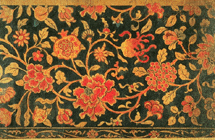In this series we will discuss DYNAMIC principles of design which will be discussed in 5 parts:
- movement
- harmony
- repetition
- rhythm
- pattern
MOVEMENT:
Movement in visual art or design occurs when we perceive that an object is in motion. Movement or motion can be shown through curves in lines or dots or patterns.

These lines dots then form shapes which in turn shows movement

HARMONY:
The pleasing agreement of parts or combination of parts in a composition --Harmony involves the selection/design of elements that share a common trait, however, Harmony becomes monotony without Variety.
Common traits orientation colors or values shape/size materials variety: the extent of the differences in design elements -- visual interest is enhanced by introducing dissimilar elements and spatial arrangements.
Harmony in visual design means all parts of the visual image relate to and complement each other.
Common traits orientation colors or values shape/size materials variety: the extent of the differences in design elements -- visual interest is enhanced by introducing dissimilar elements and spatial arrangements.
Harmony in visual design means all parts of the visual image relate to and complement each other.



REPETITION:
Repetition is the regular or harmonious recurrence of elements, including: lines, shapes, forms or colors.horizontal (beams) and vertical (columns) Rhythms / Grids, Work connecting points in space.


RHYTHM:
Rhythm is the repetition or alternation of elements, often with defined intervals between them.
Rhythm can create a sense of movement, and can establish pattern and texture. There are many
different kinds of rhythm, often defined by the feeling something evokes when viewed.


Rhythm can create a sense of movement, and can establish pattern and texture. There are many
different kinds of rhythm, often defined by the feeling something evokes when viewed.
- Regular: A regular rhythm occurs when the intervals between the elements,
- Flowing: A flowing rhythm gives a sense of movement, and is often more organic in nature
- Progressive: A progressive rhythm shows a sequence of forms through a progression of steps



PATTERN:
Pattern is an underlying structure that organizes surfaces or structures in a consistent, regular manner. Pattern can be described as a repeating unit of shape or form, but it can also be thought of as the "skeleton" that organizes the parts of a composition.Pattern exists in nature as well as in designed objects; it is useful to look at the parallels. A Harvard biologist named Peter S. Stevens has published a book entitled "Patterns in Nature" in which he claims that there are only a finite number of ways that patterns can be structured. He starts with the idea of a grid as the foundation for any structure or image. He presents a set of ways in which the points of a grid can be connected. These modes of connection become classes of pattern, which he claims can be seen in any situation, in nature and in made images, and from the microscopic to the cosmic scale.
There are various types of patterns:
There are various types of patterns:
- flow
- branching
- cracking and packing
- spiral
 |
| flow pattern |
 |
| cracking and packing |
 |
| spiral pattern |
 |
| branching |


No comments:
Post a Comment